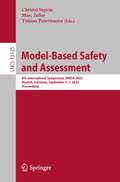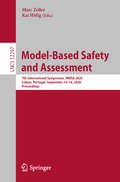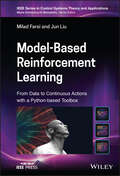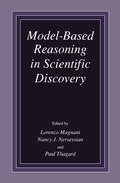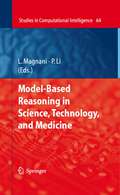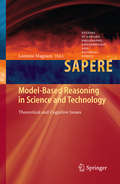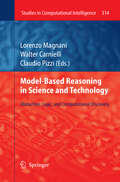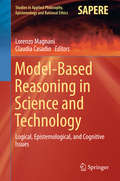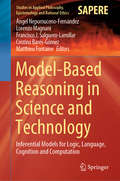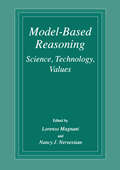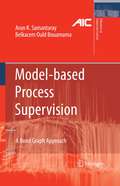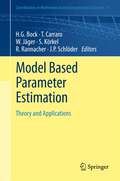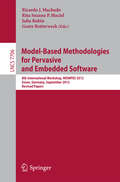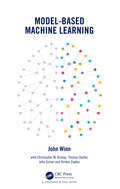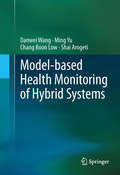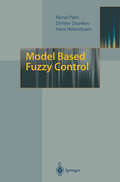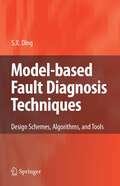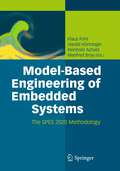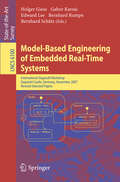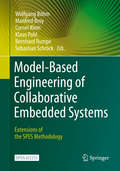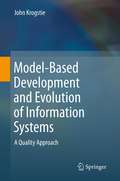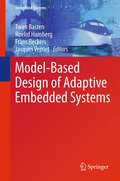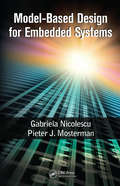- Table View
- List View
Model-Based Safety and Assessment: 8th International Symposium, IMBSA 2022, Munich, Germany, September 5–7, 2022, Proceedings (Lecture Notes in Computer Science #13525)
by Christel Seguin Marc Zeller Tatiana ProsvirnovaThis book constitutes the proceedings of the 8th International Symposium on Model-Based Safety and Assessment, IMBSA 2022, held in Munich, Germany, in September 2022. The 15 revised full papers and 3 short papers presented were carefully reviewed and selected from 27 initial submissions. The papers focus on model-based and automated ways of assessing safety and other attributes of dependability of complex systems. They are organized in topical sections on safety analysis automation, MBSA practices, causal models and failure modeling strategies, designing mitigations of faults and attacks, data based safety analysis, dynamic risk assessment.
Model-Based Safety and Assessment: 7th International Symposium, IMBSA 2020, Lisbon, Portugal, September 14–16, 2020, Proceedings (Lecture Notes in Computer Science #12297)
by Marc Zeller Kai HöfigThis book constitutes the proceedings of the 7th International Symposium on Model-Based Safety and Assessment, IMBSA 2020, held in Lisbon, Portugal, in September 2020. The conference was held virtually due to the COVID-19 pandemic. The 15 revised full papers and 4 short papers presented were carefully reviewed and selected from 30 initial submissions. The papers are organized in topical sections on safety models and languages; state-space modeling; dependability analysis process; safety assessment in automotive domain; AI and safety assurance.
Model-Based Reinforcement Learning: From Data to Continuous Actions with a Python-based Toolbox (IEEE Press Series on Control Systems Theory and Applications)
by Jun Liu Milad FarsiModel-Based Reinforcement Learning Explore a comprehensive and practical approach to reinforcement learning Reinforcement learning is an essential paradigm of machine learning, wherein an intelligent agent performs actions that ensure optimal behavior from devices. While this paradigm of machine learning has gained tremendous success and popularity in recent years, previous scholarship has focused either on theory—optimal control and dynamic programming – or on algorithms—most of which are simulation-based. Model-Based Reinforcement Learning provides a model-based framework to bridge these two aspects, thereby creating a holistic treatment of the topic of model-based online learning control. In doing so, the authors seek to develop a model-based framework for data-driven control that bridges the topics of systems identification from data, model-based reinforcement learning, and optimal control, as well as the applications of each. This new technique for assessing classical results will allow for a more efficient reinforcement learning system. At its heart, this book is focused on providing an end-to-end framework—from design to application—of a more tractable model-based reinforcement learning technique. Model-Based Reinforcement Learning readers will also find: A useful textbook to use in graduate courses on data-driven and learning-based control that emphasizes modeling and control of dynamical systems from data Detailed comparisons of the impact of different techniques, such as basic linear quadratic controller, learning-based model predictive control, model-free reinforcement learning, and structured online learning Applications and case studies on ground vehicles with nonholonomic dynamics and another on quadrator helicopters An online, Python-based toolbox that accompanies the contents covered in the book, as well as the necessary code and data Model-Based Reinforcement Learning is a useful reference for senior undergraduate students, graduate students, research assistants, professors, process control engineers, and roboticists.
Model-Based Reinforcement Learning: From Data to Continuous Actions with a Python-based Toolbox (IEEE Press Series on Control Systems Theory and Applications)
by Jun Liu Milad FarsiModel-Based Reinforcement Learning Explore a comprehensive and practical approach to reinforcement learning Reinforcement learning is an essential paradigm of machine learning, wherein an intelligent agent performs actions that ensure optimal behavior from devices. While this paradigm of machine learning has gained tremendous success and popularity in recent years, previous scholarship has focused either on theory—optimal control and dynamic programming – or on algorithms—most of which are simulation-based. Model-Based Reinforcement Learning provides a model-based framework to bridge these two aspects, thereby creating a holistic treatment of the topic of model-based online learning control. In doing so, the authors seek to develop a model-based framework for data-driven control that bridges the topics of systems identification from data, model-based reinforcement learning, and optimal control, as well as the applications of each. This new technique for assessing classical results will allow for a more efficient reinforcement learning system. At its heart, this book is focused on providing an end-to-end framework—from design to application—of a more tractable model-based reinforcement learning technique. Model-Based Reinforcement Learning readers will also find: A useful textbook to use in graduate courses on data-driven and learning-based control that emphasizes modeling and control of dynamical systems from data Detailed comparisons of the impact of different techniques, such as basic linear quadratic controller, learning-based model predictive control, model-free reinforcement learning, and structured online learning Applications and case studies on ground vehicles with nonholonomic dynamics and another on quadrator helicopters An online, Python-based toolbox that accompanies the contents covered in the book, as well as the necessary code and data Model-Based Reinforcement Learning is a useful reference for senior undergraduate students, graduate students, research assistants, professors, process control engineers, and roboticists.
Model-Based Reasoning in Scientific Discovery
by L. Magnani Nancy Nersessian Paul ThagardThe volume is based on the papers that were presented at the Interna tional Conference Model-Based Reasoning in Scientific Discovery (MBR'98), held at the Collegio Ghislieri, University of Pavia, Pavia, Italy, in December 1998. The papers explore how scientific thinking uses models and explanatory reasoning to produce creative changes in theories and concepts. The study of diagnostic, visual, spatial, analogical, and temporal rea soning has demonstrated that there are many ways of performing intelligent and creative reasoning that cannot be described with the help only of tradi tional notions of reasoning such as classical logic. Traditional accounts of scientific reasoning have restricted the notion of reasoning primarily to de ductive and inductive arguments. Understanding the contribution of model ing practices to discovery and conceptual change in science requires ex panding scientific reasoning to include complex forms of creative reasoning that are not always successful and can lead to incorrect solutions. The study of these heuristic ways of reasoning is situated at the crossroads of philoso phy, artificial intelligence, cognitive psychology, and logic; that is, at the heart of cognitive science. There are several key ingredients common to the various forms of model based reasoning to be considered in this book. The models are intended as in terpretations of target physical systems, processes, phenomena, or situations. The models are retrieved or constructed on the basis of potentially satisfying salient constraints of the target domain.
Model-Based Reasoning in Science, Technology, and Medicine (Studies in Computational Intelligence #64)
by Lorenzo Magnani Ping LiThe volume is based on papers presented at the international conference on Model-Based Reasoning in Science and Medicine held in China in 2006. The presentations explore how scientific thinking uses models and explanatory reasoning to produce creative changes in theories and concepts. The contributions to the book are written by researchers active in the area of creative reasoning in science and technology. They include the subject area’s most recent results and achievements.
Model-Based Reasoning in Science and Technology: Theoretical and Cognitive Issues (Studies in Applied Philosophy, Epistemology and Rational Ethics #8)
by Lorenzo MagnaniThis book contains contributions presented during the international conference on Model-Based Reasoning (MBR´012), held on June 21-23 in Sestri Levante, Italy. Interdisciplinary researchers discuss in this volume how scientific cognition and other kinds of cognition make use of models, abduction, and explanatory reasoning in order to produce important or creative changes in theories and concepts. Some of the contributions analyzed the problem of model-based reasoning in technology and stressed the issues of scientific and technological innovation. The book is divided in three main parts: models, mental models, representations; abduction, problem solving and practical reasoning; historical, epistemological and technological issues. The volume is based on the papers that were presented at the international
Model-Based Reasoning in Science and Technology: Abduction, Logic, and Computational Discovery (Studies in Computational Intelligence #314)
by Lorenzo Magnani Walter Carnielli Claudio PizziModel-Based Reasoning in Science and Technology: Logical, Epistemological, and Cognitive Issues (Studies in Applied Philosophy, Epistemology and Rational Ethics #27)
by Lorenzo Magnani Claudia CasadioThis book discusses how scientific and other types of cognition make use of models, abduction, and explanatory reasoning in order to produce important or creative changes in theories and concepts. It includes revised contributions presented during the international conference on Model-Based Reasoning (MBR’015), held on June 25-27 in Sestri Levante, Italy. The book is divided into three main parts, the first of which focuses on models, reasoning and representation. It highlights key theoretical concepts from an applied perspective, addressing issues concerning information visualization, experimental methods and design. The second part goes a step further, examining abduction, problem solving and reasoning. The respective contributions analyze different types of reasoning, discussing various concepts of inference and creativity and their relationship with experimental data. In turn, the third part reports on a number of historical, epistemological and technological issues. By analyzing possible contradictions in modern research and describing representative case studies in experimental research, this part aims at fostering new discussions and stimulating new ideas. All in all, the book provides researchers and graduate students in the field of applied philosophy, epistemology, cognitive science and artificial intelligence alike with an authoritative snapshot of current theories and applications of model-based reasoning.
Model-Based Reasoning in Science and Technology: Inferential Models for Logic, Language, Cognition and Computation (Studies in Applied Philosophy, Epistemology and Rational Ethics #49)
by Ángel Nepomuceno-Fernández Lorenzo Magnani Francisco J. Salguero-Lamillar Cristina Barés-Gómez Matthieu FontaineThis book discusses how scientific and other types of cognition make use of models, abduction, and explanatory reasoning in order to produce important and innovative changes in theories and concepts. Gathering revised contributions presented at the international conference on Model-Based Reasoning (MBR18), held on October 24–26 2018 in Seville, Spain, the book is divided into three main parts. The first focuses on models, reasoning, and representation. It highlights key theoretical concepts from an applied perspective, and addresses issues concerning information visualization, experimental methods, and design. The second part goes a step further, examining abduction, problem solving, and reasoning. The respective papers assess different types of reasoning, and discuss various concepts of inference and creativity and their relationship with experimental data. In turn, the third part reports on a number of epistemological and technological issues. By analyzing possible contradictions in modern research and describing representative case studies, this part is intended to foster new discussions and stimulate new ideas. All in all, the book provides researchers and graduate students in the fields of applied philosophy, epistemology, cognitive science, and artificial intelligence alike with an authoritative snapshot of the latest theories and applications of model-based reasoning.
Model-Based Reasoning: Science, Technology, Values (Studies In Applied Philosophy, Epistemology And Rational Ethics Ser. #27)
by Lorenzo Magnani Nancy J. NersessianThere are several key ingredients common to the various forms of model-based reasoning considered in this book. The term ‘model’ comprises both internal and external representations. The models are intended as interpretations of target physical systems, processes, phenomena, or situations and are retrieved or constructed on the basis of potentially satisfying salient constraints of the target domain. The book’s contributors are researchers active in the area of creative reasoning in science and technology.
Model-based Process Supervision: A Bond Graph Approach (Advances in Industrial Control)
by Arun Kumar Samantaray Belkacem Ould BouamamaThis book provides control engineers and workers in industrial and academic research establishments interested in process engineering with a means to build up a practical and functional supervisory control environment and to use sophisticated models to get the best use out of their process data. Several applications to academic and small-scale-industrial processes are discussed and the development of a supervision platform for an industrial plant is presented.
Model Based Parameter Estimation: Theory and Applications (Contributions in Mathematical and Computational Sciences #4)
by Hans Georg Bock, Thomas Carraro, Willi Jäger, Stefan Körkel, Rolf Rannacher and Johannes P. SchlöderThis judicious selection of articles combines mathematical and numerical methods to apply parameter estimation and optimum experimental design in a range of contexts. These include fields as diverse as biology, medicine, chemistry, environmental physics, image processing and computer vision. The material chosen was presented at a multidisciplinary workshop on parameter estimation held in 2009 in Heidelberg. The contributions show how indispensable efficient methods of applied mathematics and computer-based modeling can be to enhancing the quality of interdisciplinary research. The use of scientific computing to model, simulate, and optimize complex processes has become a standard methodology in many scientific fields, as well as in industry. Demonstrating that the use of state-of-the-art optimization techniques in a number of research areas has much potential for improvement, this book provides advanced numerical methods and the very latest results for the applications under consideration.
Model-Based Methodologies for Pervasive and Embedded Software: 8th International Workshop, MOMPES 2012, Essen, Germany, September 4, 2012, Revised Papers (Lecture Notes in Computer Science #7706)
by Ricardo J. Machado Rita Suzana Maciel Julia Rubin Goetz BotterweckThis book constitutes the thoroughly refereed post-conference proceedings of the 8th International Workshop on Model-Based Methodologies for Pervasive and Embedded Software, MOMPES 2012, held in Essen, Germany, in September 2012. The 7 revised full papers presented together with 1 short papers were carefully reviewed and selected from 16 submissions. The papers cover a large spectrum of topics including model-driven engineering, model analysis, runtime verification, modeling of reactive systems, variability modeling, and domain-specific languages.
Model-Based Machine Learning
by John WinnToday, machine learning is being applied to a growing variety of problems in a bewildering variety of domains. A fundamental challenge when using machine learning is connecting the abstract mathematics of a machine learning technique to a concrete, real world problem. This book tackles this challenge through model-based machine learning which focuses on understanding the assumptions encoded in a machine learning system and their corresponding impact on the behaviour of the system. The key ideas of model-based machine learning are introduced through a series of case studies involving real-world applications. Case studies play a central role because it is only in the context of applications that it makes sense to discuss modelling assumptions. Each chapter introduces one case study and works through step-by-step to solve it using a model-based approach. The aim is not just to explain machine learning methods, but also showcase how to create, debug, and evolve them to solve a problem. Features: Explores the assumptions being made by machine learning systems and the effect these assumptions have when the system is applied to concrete problems Explains machine learning concepts as they arise in real-world case studies Shows how to diagnose, understand and address problems with machine learning systems Full source code available, allowing models and results to be reproduced and explored Includes optional deep-dive sections with more mathematical details on inference algorithms for the interested reader Jo
Model-Based Machine Learning
by John WinnToday, machine learning is being applied to a growing variety of problems in a bewildering variety of domains. A fundamental challenge when using machine learning is connecting the abstract mathematics of a machine learning technique to a concrete, real world problem. This book tackles this challenge through model-based machine learning which focuses on understanding the assumptions encoded in a machine learning system and their corresponding impact on the behaviour of the system. The key ideas of model-based machine learning are introduced through a series of case studies involving real-world applications. Case studies play a central role because it is only in the context of applications that it makes sense to discuss modelling assumptions. Each chapter introduces one case study and works through step-by-step to solve it using a model-based approach. The aim is not just to explain machine learning methods, but also showcase how to create, debug, and evolve them to solve a problem. Features: Explores the assumptions being made by machine learning systems and the effect these assumptions have when the system is applied to concrete problems Explains machine learning concepts as they arise in real-world case studies Shows how to diagnose, understand and address problems with machine learning systems Full source code available, allowing models and results to be reproduced and explored Includes optional deep-dive sections with more mathematical details on inference algorithms for the interested reader Jo
Model-based Health Monitoring of Hybrid Systems
by Danwei Wang Ming Yu Chang Boon Low Shai ArogetiThis book systematically presents a comprehensive framework and effective techniques for in-depth analysis, clear design procedure, and efficient implementation of diagnosis and prognosis algorithms for hybrid systems. It offers an overview of the fundamentals of diagnosis\prognosis and hybrid bond graph modeling. This book also describes hybrid bond graph-based quantitative fault detection, isolation and estimation. Moreover, it also presents strategies to track the system mode and predict the remaining useful life under multiple fault condition. A real world complex hybrid system—a vehicle steering control system—is studied using the developed fault diagnosis methods to show practical significance. Readers of this book will benefit from easy-to-understand fundamentals of bond graph models, concepts of health monitoring, fault diagnosis and failure prognosis, as well as hybrid systems. The reader will gain knowledge of fault detection and isolation in complex systems including those with hybrid nature, and will learn state-of-the-art developments in theory and technologies of fault diagnosis and failure prognosis for complex systems.
Model Based Fuzzy Control: Fuzzy Gain Schedulers and Sliding Mode Fuzzy Controllers
by Rainer Palm Dimiter Driankov Hans HellendoornModel Based Fuzzy Control uses a given conventional or fuzzy open loop model of the plant under control to derive the set of fuzzy rules for the fuzzy controller. Of central interest are the stability, performance, and robustness of the resulting closed loop system. The major objective of model based fuzzy control is to use the full range of linear and nonlinear design and analysis methods to design such fuzzy controllers with better stability, performance, and robustness properties than non-fuzzy controllers designed using the same techniques. This objective has already been achieved for fuzzy sliding mode controllers and fuzzy gain schedulers - the main topics of this book. The primary aim of the book is to serve as a guide for the practitioner and to provide introductory material for courses in control theory.
Model-based Fault Diagnosis Techniques: Design Schemes, Algorithms, and Tools
by Steven X. DingThe objective of this book is to introduce basic model-based FDI schemes, advanced analysis and design algorithms, and the needed mathematical and control theory tools at a level for graduate students and researchers as well as for engineers. This is a textbook with extensive examples and references. Most methods are given in the form of an algorithm that enables a direct implementation in a programme. Comparisons among different methods are included when possible.
Model-Based Engineering of Embedded Systems: The SPES 2020 Methodology
by Klaus Pohl Harald Hönninger Reinhold Achatz Manfred BroyEmbedded systems have long become essential in application areas in which human control is impossible or infeasible. The development of modern embedded systems is becoming increasingly difficult and challenging because of their overall system complexity, their tighter and cross-functional integration, the increasing requirements concerning safety and real-time behavior, and the need to reduce development and operation costs.This book provides a comprehensive overview of the Software Platform Embedded Systems (SPES) modeling framework and demonstrates its applicability in embedded system development in various industry domains such as automation, automotive, avionics, energy, and healthcare. In SPES 2020, twenty-one partners from academia and industry have joined forces in order to develop and evaluate in different industrial domains a modeling framework that reflects the current state of the art in embedded systems engineering.The content of this book is structured in four parts. Part I “Starting Point” discusses the status quo of embedded systems development and model-based engineering, and summarizes the key requirements faced when developing embedded systems in different application domains. Part II “The SPES Modeling Framework” describes the SPES modeling framework. Part III “Application and Evaluation of the SPES Modeling Framework” reports on the validation steps taken to ensure that the framework met the requirements discussed in Part I. Finally, Part IV “Impact of the SPES Modeling Framework” summarizes the results achieved and provides an outlook on future work.The book is mainly aimed at professionals and practitioners who deal with the development of embedded systems on a daily basis. Researchers in academia and industry may use it as a compendium for the requirements and state-of-the-art solution concepts for embedded systems development.
Model-Based Engineering of Embedded Real-Time Systems: International Dagstuhl Workshop, Dagstuhl Castle, Germany, November 4-9, 2007. Revised Selected Papers (Lecture Notes in Computer Science #6100)
by Bernhard Schätz Holger Giese Gabor Karsai Edward A. Lee Bernhard RumpeThetopicof“Model-BasedEngineeringofReal-TimeEmbeddedSystems”brings together a challenging problem domain (real-time embedded systems) and a - lution domain (model-based engineering). It is also at the forefrontof integrated software and systems engineering, as software in this problem domain is an essential tool for system implementation and integration. Today, real-time - bedded software plays a crucial role in most advanced technical systems such as airplanes, mobile phones, and cars, and has become the main driver and - cilitator for innovation. Development, evolution, veri?cation, con?guration, and maintenance of embedded and distributed software nowadays are often serious challenges as drastic increases in complexity can be observed in practice. Model-based engineering in general, and model-based software development in particular, advocates the notion of using models throughout the development and life-cycle of an engineered system. Model-based software engineering re- forces this notion by promoting models not only as the tool of abstraction, but also as the tool for veri?cation, implementation, testing, and maintenance. The application of such model-based engineering techniques to embedded real-time systems appears to be a good candidate to tackle some of the problems arising in the problem domain.
Model-Based Engineering of Collaborative Embedded Systems: Extensions of the SPES Methodology
This Open Access book presents the results of the "Collaborative Embedded Systems" (CrESt) project, aimed at adapting and complementing the methodology underlying modeling techniques developed to cope with the challenges of the dynamic structures of collaborative embedded systems (CESs) based on the SPES development methodology.In order to manage the high complexity of the individual systems and the dynamically formed interaction structures at runtime, advanced and powerful development methods are required that extend the current state of the art in the development of embedded systems and cyber-physical systems. The methodological contributions of the project support the effective and efficient development of CESs in dynamic and uncertain contexts, with special emphasis on the reliability and variability of individual systems and the creation of networks of such systems at runtime.The project was funded by the German Federal Ministry of Education and Research (BMBF), and the case studies are therefore selected from areas that are highly relevant for Germany’s economy (automotive, industrial production, power generation, and robotics). It also supports the digitalization of complex and transformable industrial plants in the context of the German government's "Industry 4.0" initiative, and the project results provide a solid foundation for implementing the German government's high-tech strategy "Innovations for Germany" in the coming years.
Model-Based Development and Evolution of Information Systems: A Quality Approach
by John KrogstieThis book introduces and describes in detail the SEQUAL framework for understanding the quality of models and modeling languages, including the numerous specializations of the generic framework, and the various ways in which this can be used for different applications. Topics and features: contains case studies, chapter summaries, review questions, problems and exercises throughout the text, in addition to Appendices on terminology and abbreviations; presents a thorough introduction to the most important concepts in conceptual modeling, including the underlying philosophical outlook on the quality of models; describes the basic tasks and model types in information systems development and evolution, and the main methodologies for mixing different phases of information system development; provides an overview of the general mechanisms and perspectives used in conceptual modeling; predicts future trends in technological development, and discusses how the role of modeling can be envisaged in this landscape.
Model-Based Design of Adaptive Embedded Systems (Embedded Systems)
by Twan Basten, Roelof Hamberg, Frans Reckers and Jacques VerrietThis book describes model-based development of adaptive embedded systems, which enable improved functionality using the same resources. The techniques presented facilitate design from a higher level of abstraction, focusing on the problem domain rather than on the solution domain, thereby increasing development efficiency. Models are used to capture system specifications and to implement (manually or automatically) system functionality. The authors demonstrate the real impact of adaptivity on engineering of embedded systems by providing several industrial examples of the models used in the development of adaptive embedded systems.
Model-Based Design for Embedded Systems (Computational Analysis, Synthesis, and Design of Dynamic Systems)
by Gabriela Nicolescu Pieter J. MostermanThe demands of increasingly complex embedded systems and associated performance computations have resulted in the development of heterogeneous computing architectures that often integrate several types of processors, analog and digital electronic components, and mechanical and optical components—all on a single chip. As a result, now the most prominent challenge for the design automation community is to efficiently plan for such heterogeneity and to fully exploit its capabilities.A compilation of work from internationally renowned authors, Model-Based Design for Embedded Systems elaborates on related practices and addresses the main facets of heterogeneous model-based design for embedded systems, including the current state of the art, important challenges, and the latest trends. Focusing on computational models as the core design artifact, this book presents the cutting-edge results that have helped establish model-based design and continue to expand its parameters.The book is organized into three sections: Real-Time and Performance Analysis in Heterogeneous Embedded Systems, Design Tools and Methodology for Multiprocessor System-on-Chip, and Design Tools and Methodology for Multidomain Embedded Systems. The respective contributors share their considerable expertise on the automation of design refinement and how to relate properties throughout this refinement while enabling analytic and synthetic qualities. They focus on multi-core methodological issues, real-time analysis, and modeling and validation, taking into account how optical, electronic, and mechanical components often interface. Model-based design is emerging as a solution to bridge the gap between the availability of computational capabilities and our inability to make full use of them yet. This approach enables teams to start the design process using a high-level model that is gradually refined through abstraction levels to ultimately yield a prototype. When executed well, model-based design encourages enhanced performance and quicker time to market for a product. Illustrating a broad and diverse spectrum of applications such as in the automotive aerospace, health care, consumer electronics, this volume provides designers with practical, readily adaptable modeling solutions for their own practice.
